- Home
- About Journals
-
Information for Authors/ReviewersEditorial Policies
Publication Fee
Publication Cycle - Process Flowchart
Online Manuscript Submission and Tracking System
Publishing Ethics and Rectitude
Authorship
Author Benefits
Reviewer Guidelines
Guest Editor Guidelines
Peer Review Workflow
Quick Track Option
Copyediting Services
Bentham Open Membership
Bentham Open Advisory Board
Archiving Policies
Fabricating and Stating False Information
Post Publication Discussions and Corrections
Editorial Management
Advertise With Us
Funding Agencies
Rate List
Kudos
General FAQs
Special Fee Waivers and Discounts
- Contact
- Help
- About Us
- Search

The Open Electrical & Electronic Engineering Journal
(Discontinued)
ISSN: 1874-1290 ― Volume 13, 2019
Correction of Known Position Errors in a Spherical Near to Far-Field Transformation for Long Antennas
Renato Cicchetti1, Francesco D’Agostino2, Flaminio Ferrara2, Claudio Gennarelli2, *, Rocco Guerriero2, Massimo Migliozzi2
Abstract
Background:
This paper provides the experimental validation of an efficient iterative procedure to correct known position errors in a spherical near to far-field (NTFF) transformation for elongated antennas which uses a minimum number of NF measurements.
Method:
This transformation exploits a non-redundant sampling representation of the voltage detected by the probe obtained by shaping a long antenna with a prolate ellipsoid. The uniform samples, those at the points set by the representation, are accurately reconstructed from the acquired not regularly distributed (non-uniform) ones by using an iterative scheme, which requires a one to one relationship between each uniform sampling point and the corresponding non-uniform one. Then a 2-D optimal sampling formula is adopted to evaluate the input data needed to perform the traditional spherical NTFF transformation from the retrieved non-redundant uniform samples.
Conclusion:
Finally, laboratory proofs have been reported to demonstrate the validity of the presented technique from a practical viewpoint.
Article Information
Identifiers and Pagination:
Year: 2017Volume: 11
First Page: 141
Last Page: 153
Publisher Id: TOEEJ-11-141
DOI: 10.2174/1874129001711010141
Article History:
Received Date: 07/02/2017Revision Received Date: 07/04/2017
Acceptance Date: 15/05/2017
Electronic publication date: 31/07/2017
Collection year: 2017
open-access license: This is an open access article distributed under the terms of the Creative Commons Attribution 4.0 International Public License (CC-BY 4.0), a copy of which is available at: https://creativecommons.org/licenses/by/4.0/legalcode. This license permits unrestricted use, distribution, and reproduction in any medium, provided the original author and source are credited.
* Address correspondence to this author at the Department of Industrial Engineering, University of Salerno, Via Giovanni Paolo II, 132 - 84084 Fisciano (SA), Italy; Tel: +39 089-964297; Fax: +39 089-968730; E-mail: cgennarelli@unisa.it
| Open Peer Review Details | |||
|---|---|---|---|
| Manuscript submitted on 07-02-2017 |
Original Manuscript | Correction of Known Position Errors in a Spherical Near to Far-Field Transformation for Long Antennas | |
1. INTRODUCTION
Near to far-field (NTFF) transformation techniques are widely employed tools for the prediction of the antenna FF pattern from NF measurements [1A.D. Yaghjian, "An overview of near-field antenna measurements", IEEE Trans. Antenn. Propag., vol. AP-34, pp. 30-45, 1986.
[http://dx.doi.org/10.1109/TAP.1986.1143727] -4C. Gennarelli, A. Capozzoli, L. Foged, J. Fordham, D.J. van Rensburg, Eds., “Recent advances in near-field to far-field transformation techniques”, Int. J. Antennas Prop., vol. 2012, ID 243203, pp. 1-3, 2012.
[http://dx.doi.org/10.1155/2012/243203] ]. Among these techniques, the one wherein the NF data are acquired over a spherical surface [5J. Hald, J.E. Hansen, F. Jensen, and F.H. Larsen, Spherical Near-Field Antenna Measurements., J.E. Hansen, Ed., Peter Peregrinus: London, 1998] is the most appealing because of its unique feature to allow the reconstruction of the whole antenna radiation pattern avoiding the measurement area truncation. Therefore, it has attracted a considerable attention (see, f.i., [5J. Hald, J.E. Hansen, F. Jensen, and F.H. Larsen, Spherical Near-Field Antenna Measurements., J.E. Hansen, Ed., Peter Peregrinus: London, 1998-16F. D’Agostino, F. Ferrara, C. Gennarelli, R. Guerriero, and M. Migliozzi, “Experimental testing of nonredundant near-field to far-field transformations withspherical scanning using flexible modellings for nonvolumetric antennas”, Int. J. Antennas Prop., vol. 2013, ID 517934, pp. 1-10, 2013.
[http://dx.doi.org/10.1155/2013/517934] ]).
The traditional spherical NTFF transformation has been properly optimized in [13O.M. Bucci, C. Gennarelli, G. Riccio, and C. Savarese, "Data reduction in the NF–FF transformation technique with spherical scanning", J. Electromagn. Waves Appl., vol. 15, pp. 755-775, 2001.
[http://dx.doi.org/10.1163/156939301X00995] ] by taking into account that the electromagnetic (EM) fields radiated by finite sizes sources are spatially quasi-bandlimited functions [17O.M. Bucci, and G. Franceschetti, "On the spatial bandwidth of scattered fields", IEEE Trans. Antenn. Propag., vol. 35, pp. 1445-1455, 1987.
[http://dx.doi.org/10.1109/TAP.1987.1144024] ]. This has made possible to rigorously determine the highest spherical wave to be considered, instead to fix it according to the rule of the minimum sphere, i.e., the smallest one containing the Antenna Under Test (AUT). In addition, it has been proved that the number of NF measurements to be collected on the parallels reduces as their distance from the equator increases. The non-redundant sampling representations of the EM fields [18O.M. Bucci, C. Gennarelli, and C. Savarese, "Representation of electromagnetic fields over arbitrary surfaces by a finite and non redundant number of samples", IEEE Trans. Antenn. Propag., vol. 46, pp. 351-359, 1998.
[http://dx.doi.org/10.1109/8.662654] ] have been usefully exploited in the same paper for developing effective non-redundant NTFF transformations, requiring a NF data number drastically lower than the one necessary for the standard transformation [5J. Hald, J.E. Hansen, F. Jensen, and F.H. Larsen, Spherical Near-Field Antenna Measurements., J.E. Hansen, Ed., Peter Peregrinus: London, 1998], when considering quasi-planar or elongated antennas, which are supposed as contained in an oblate or a prolate spheroid. These NTFF transformation techniques employ optimal sampling interpolation (OSI) formulas to precisely reconstruct the NF data necessary for the standard transformation from the acquired non-redundant ones. In such a way, a very considerable saving of the measurement time is gained which is an important outcome, since the time required to acquire the NF data is greater and greater than the one needed to execute the NTFF transformation. The non-redundant sampling representations [18O.M. Bucci, C. Gennarelli, and C. Savarese, "Representation of electromagnetic fields over arbitrary surfaces by a finite and non redundant number of samples", IEEE Trans. Antenn. Propag., vol. 46, pp. 351-359, 1998.
[http://dx.doi.org/10.1109/8.662654] ] can be exploited also for the voltage measured by a non-directive probe, because its spatial bandwidth practically coincides with that of the AUT radiated field. Accordingly, the hypothesis of an ideal probe made by Bucci et al. [13O.M. Bucci, C. Gennarelli, G. Riccio, and C. Savarese, "Data reduction in the NF–FF transformation technique with spherical scanning", J. Electromagn. Waves Appl., vol. 15, pp. 755-775, 2001.
[http://dx.doi.org/10.1163/156939301X00995] ] has been relaxed by D’Agostino et al. [14F. D’Agostino, F. Ferrara, C. Gennarelli, R. Guerriero, and M. Migliozzi, “Effective antenna modellings for NF-FF transformations with spherical scanning using the minimum number of data”, Int. J. Antennas Prop., vol. 2011, ID 936781, pp. 1-11, 2011.
[http://dx.doi.org/10.1155/2011/936781] ], thus developing efficient probe compensated NTFF transformations with spherical scan tailored for quasi-planar or long antennas, which require a non-redundant, i.e. minimum, number of NF data. In particular, quasi-planar AUTs have been considered as contained in an oblate ellipsoid [13O.M. Bucci, C. Gennarelli, G. Riccio, and C. Savarese, "Data reduction in the NF–FF transformation technique with spherical scanning", J. Electromagn. Waves Appl., vol. 15, pp. 755-775, 2001.
[http://dx.doi.org/10.1163/156939301X00995] ] or in a surface consisting of two circular bowls having the same aperture and eventually different lateral surfaces (double bowl) [14F. D’Agostino, F. Ferrara, C. Gennarelli, R. Guerriero, and M. Migliozzi, “Effective antenna modellings for NF-FF transformations with spherical scanning using the minimum number of data”, Int. J. Antennas Prop., vol. 2011, ID 936781, pp. 1-11, 2011.
[http://dx.doi.org/10.1155/2011/936781] ], whereas a prolate ellipsoid [13O.M. Bucci, C. Gennarelli, G. Riccio, and C. Savarese, "Data reduction in the NF–FF transformation technique with spherical scanning", J. Electromagn. Waves Appl., vol. 15, pp. 755-775, 2001.
[http://dx.doi.org/10.1163/156939301X00995] ] or a cylindrical surface with two hemispherical caps (rounded cylinder) [14F. D’Agostino, F. Ferrara, C. Gennarelli, R. Guerriero, and M. Migliozzi, “Effective antenna modellings for NF-FF transformations with spherical scanning using the minimum number of data”, Int. J. Antennas Prop., vol. 2011, ID 936781, pp. 1-11, 2011.
[http://dx.doi.org/10.1155/2011/936781] ] has been employed to model long antennas. The experimental validations of the aforementioned non-redundant spherical NTFF transformations [13O.M. Bucci, C. Gennarelli, G. Riccio, and C. Savarese, "Data reduction in the NF–FF transformation technique with spherical scanning", J. Electromagn. Waves Appl., vol. 15, pp. 755-775, 2001.
[http://dx.doi.org/10.1163/156939301X00995] ] and [14F. D’Agostino, F. Ferrara, C. Gennarelli, R. Guerriero, and M. Migliozzi, “Effective antenna modellings for NF-FF transformations with spherical scanning using the minimum number of data”, Int. J. Antennas Prop., vol. 2011, ID 936781, pp. 1-11, 2011.
[http://dx.doi.org/10.1155/2011/936781] ] have been then provided by D’Agostino et al. [15F. D’Agostino, F. Ferrara, C. Gennarelli, R. Guerriero, and M. Migliozzi, "Non-redundant spherical NF – FF transformations using ellipsoidal antenna modeling: experimental assessments", IEEE Antennas Propag. Mag., vol. 55, pp. 166-175, 2013.
[http://dx.doi.org/10.1109/MAP.2013.6645164] ] and [16F. D’Agostino, F. Ferrara, C. Gennarelli, R. Guerriero, and M. Migliozzi, “Experimental testing of nonredundant near-field to far-field transformations withspherical scanning using flexible modellings for nonvolumetric antennas”, Int. J. Antennas Prop., vol. 2013, ID 517934, pp. 1-10, 2013.
[http://dx.doi.org/10.1155/2013/517934] ], respectively.
It must be noticed that, owing to the not accurate control of the positioners and/or to their limited resolution, it could not be possible to get the NF measurements at the points prescribed by the non-redundant sampling representation, even if the positions of the actual acquisition points can be precisely revealed through laser interferometric techniques. Hence, the development of an effective and robust procedure, allowing a possibly accurate retrieval of the NF data to be used in the NTFF transformation from the positioning errors affected (non-uniform) ones, appears to be of crucial importance. For this purpose, a procedure based on the conjugate gradient iterative technique and adopting the fast Fourier transform for non-equispaced data [19A. Dutt, and V. Rohklin, "Fast Fourier transforms for nonequispaced data", Proc. SIAM J. Sci. Comp., vol. 14, pp. 1369-1393, 1993.] has been exploited to correct the position errors in the traditional NTFF transformation techniques employing the planar [20R.C. Wittmann, B.K. Alpert, and M.H. Francis, "Near-field antenna measurements using nonideal measurement locations", IEEE Trans. Antenn. Propag., vol. 46, pp. 716-722, 1998.
[http://dx.doi.org/10.1109/8.668916] ] and spherical [21R.C. Wittmann, B.K. Alpert, and M.H. Francis, "Near-Field, spherical scanning antenna measurements with nonideal probe locations", IEEE Trans. Antenn. Propag., vol. 52, pp. 2184-2186, 2004.
[http://dx.doi.org/10.1109/TAP.2004.832316] ] scans. In any case, such a procedure is inappropriate for the abovementioned non-redundant spherical NTFF transformations, where the information about the AUT geometry is conveniently exploited and proper OSI expansions are applied to efficiently evaluate the NF data needed by the traditional NTFF transformation from the non-redundant acquired ones. As it has been explicitly pointed out by Bucci et al. [22O.M. Bucci, C. Gennarelli, and C. Savarese, "Interpolation of electromagnetic radiated fields over a plane from nonuniform samples", IEEE Trans. Antenn. Propag., vol. 41, pp. 1501-1508, 1993.
[http://dx.doi.org/10.1109/8.267349] ] and by D’Agostino et al. [23F. D’Agostino, F. Ferrara, C. Gennarelli, R. Guerriero, and M. Migliozzi, "Two effective approaches to correct the positioning errors in a spherical near-field-far-field transformation", Electromag, vol. 36, pp. 78-93, 2016.
[http://dx.doi.org/10.1080/02726343.2016.1136018] ], where the interested reader can find a more complete discussion, the available formulas, which allow one to directly reconstruct the needed data from the non-uniform samples, are not stable and easy to use, and applicable only to specific samples grids. As stressed by Bucci et al. [22O.M. Bucci, C. Gennarelli, and C. Savarese, "Interpolation of electromagnetic radiated fields over a plane from nonuniform samples", IEEE Trans. Antenn. Propag., vol. 41, pp. 1501-1508, 1993.
[http://dx.doi.org/10.1109/8.267349] ], a viable and opportune policy is to recover the regularly spaced (uniform) samples from the non-uniform ones and then evaluate the required values through a precise and robust OSI expansion. Two distinct procedures have been proposed to this purpose. The first adopts an iterative technique, which converges only when it is possible to set up a bijective relation between every uniform sampling point and the nearest non-uniform one, and has been employed for recovering the uniform samples in a plane-rectangular grid [22O.M. Bucci, C. Gennarelli, and C. Savarese, "Interpolation of electromagnetic radiated fields over a plane from nonuniform samples", IEEE Trans. Antenn. Propag., vol. 41, pp. 1501-1508, 1993.
[http://dx.doi.org/10.1109/8.267349] ]. The second exploits the singular value decomposition (SVD) method, does not suffer from the aforementioned shortcoming, allows one to benefit from the data redundancy for increasing the algorithm robustness with regard to errors corrupting the data, and has been employed to develop non-redundant NTFF transformations from positioning errors affected samples with plane-polar [24F. Ferrara, C. Gennarelli, G. Riccio, and C. Savarese, "Far field reconstruction from nonuniform plane-polar data: a SVD based approach", Electromag, vol. 23, pp. 417-429, 2003.
[http://dx.doi.org/10.1080/02726340390203171] ] and cylindrical [25F. Ferrara, C. Gennarelli, G. Riccio, and C. Savarese, "NF–FF transformation with cylindrical scanning from nonuniformly distributed data", Microw. Opt. Technol. Lett., vol. 39, pp. 4-8, 2003.
[http://dx.doi.org/10.1002/mop.11109] ] scans. Anyhow, it can be profitably adopted if the starting 2-D problem of the retrieval of the uniformly spaced samples can be subdivided in two independent 1-D problems; otherwise, the sizes of the related matrices remarkably increase, thus requiring a bulky computing effort. Both the procedures have been numerically compared and experimentally demonstrated in [26F. D’Agostino, F. Ferrara, C. Gennarelli, R. Guerriero, and M. Migliozzi, "On the compensation of probe positioning errors when using a nonredundant cylindrical NF–FF transformation", Prog. Electromagn. Res. B, vol. 20, pp. 321-335, 2010.
[http://dx.doi.org/10.2528/PIERB10032402] ] with reference to the cylindrical NTFF transformation from irregularly spaced samples, whereas their experimental assessment in the plane-polar scanning case has been recently provided in [27F. D’Agostino, F. Ferrara, C. Gennarelli, R. Guerriero, and M. Migliozzi, "Two efficient procedures to correct the positioning errors in the plane-polar scanning", IET Microw. Antennas Propag., vol. 10, no. 13, pp. 1453-1458, 2016.
[http://dx.doi.org/10.1049/iet-map.2016.0103] ]. Coming now to the spherical scanning case, these procedures have been applied and numerically compared with reference to the correction of the errors of probe positioning in the NTFF transformations for long [28F. D’Agostino, F. Ferrara, C. Gennarelli, R. Guerriero, and M. Migliozzi, “Two techniques for compensating the probe positioning errors in the spherical NF–FF transformation for elongated antennas”, Open Electr. Electron. Eng. J., vol. 5, pp. 29–36, 2011.] and quasi-planar [29F. D’Agostino, F. Ferrara, C. Gennarelli, R. Guerriero, and M. Migliozzi, "Spherical near-field – far-field transformation for quasi-planar antennas from irregularly spaced data", J. Electromagn. Analysis Appl., vol. 4, pp. 147-155, 2012.
[http://dx.doi.org/10.4236/jemaa.2012.44019]] ] antennas using a prolate and oblate ellipsoidal AUT modelling, respectively. Then, both the iterative and SVD based approaches have been numerically compared and experimentally assessed in the cases of the spherical NTFF transformations for quasi-planar [23F. D’Agostino, F. Ferrara, C. Gennarelli, R. Guerriero, and M. Migliozzi, "Two effective approaches to correct the positioning errors in a spherical near-field-far-field transformation", Electromag, vol. 36, pp. 78-93, 2016.
[http://dx.doi.org/10.1080/02726343.2016.1136018] ] and elongated [30F. D’Agostino, F. Ferrara, C. Gennarelli, R. Guerriero, and M. Migliozzi, "Probe position errors corrected near-field-far-field transformation with spherical scanning", Appl. Comput. Electromagn. Soc. J., vol. 31, pp. 106-117, 2016.] antennas based on the double bowl and rounded cylinder source models, respectively. At last, they have been experimentally assessed in the case of the NTFF transformation adopting oblate spheroids to fit quasi-planar AUTs [31F. D’Agostino, F. Ferrara, C. Gennarelli, R. Guerriero, and M. Migliozzi, "Far-field pattern evaluation from data acquired on a spherical surface by an inaccurately positioned probe", IEEE Antennas Wirel. Propag. Lett., vol. 15, pp. 402-405, 2016.
[http://dx.doi.org/10.1109/LAWP.2015.2447840] ], whereas only the experimental assessment of the SVD based approach has been provided [32F. D’Agostino, F. Ferrara, C. Gennarelli, R. Guerriero, and M. Migliozzi, "Experimental validation of the SVD based approach to compensate the positioning errors in a nonredundant spherical NF–FF transformation", In: Proceeding of LAPC, 2014, pp. 31-35.
[http://dx.doi.org/10.1109/LAPC.2014.6996313] ] for the NTFF transformation relying on the prolate ellipsoidal modelling.
The goal of the paper is to give a laboratory assessment of the iterative technique proposed by F. D’Agostino et al. [28F. D’Agostino, F. Ferrara, C. Gennarelli, R. Guerriero, and M. Migliozzi, “Two techniques for compensating the probe positioning errors in the spherical NF–FF transformation for elongated antennas”, Open Electr. Electron. Eng. J., vol. 5, pp. 29–36, 2011.] for correcting the position errors in the non-redundant spherical NTFF transformation for elongated AUTs [13O.M. Bucci, C. Gennarelli, G. Riccio, and C. Savarese, "Data reduction in the NF–FF transformation technique with spherical scanning", J. Electromagn. Waves Appl., vol. 15, pp. 755-775, 2001.
[http://dx.doi.org/10.1163/156939301X00995] ], using the prolate ellipsoidal source model (see Fig. 1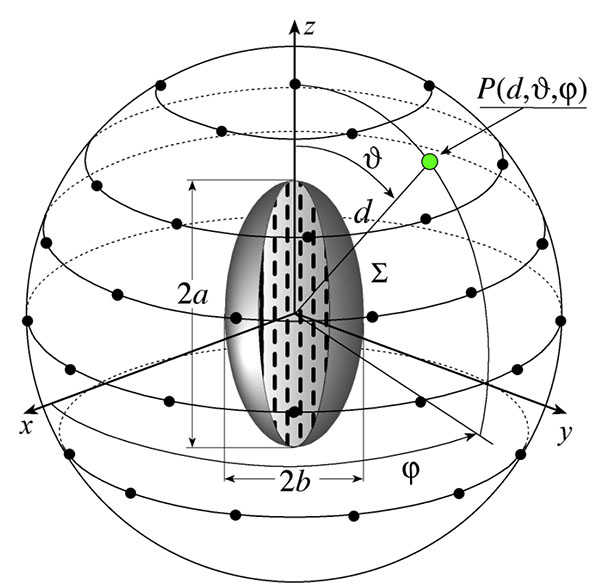 ). The measurements have been accomplished by using the roll-over-azimuth spherical NF scanning system available at the Antenna Characterization Lab of the UNIversity of SAlerno (UNISA).
). The measurements have been accomplished by using the roll-over-azimuth spherical NF scanning system available at the Antenna Characterization Lab of the UNIversity of SAlerno (UNISA).
 |
Fig. (1) Spherical scan for a long antenna. |
2. PROBE VOLTAGE NON-REDUNDANT REPRESENTATION ON A SPHERICAL SURFACE FROM NON-UNIFORM SAMPLES
2.1. Uniform Samples Representation
Let us consider an elongated AUT, a non-directive probe which scans a sphere of radius d located in its NF region, and a spherical reference system (r, ϑ, φ) to denote any observation point P. As discussed in the Introduction, the non-redundant sampling representations [18O.M. Bucci, C. Gennarelli, and C. Savarese, "Representation of electromagnetic fields over arbitrary surfaces by a finite and non redundant number of samples", IEEE Trans. Antenn. Propag., vol. 46, pp. 351-359, 1998.
[http://dx.doi.org/10.1109/8.662654] ] can be profitably exploited to represent the voltage measured by such a type of probe.
According to these representations, the AUT must be considered as surrounded by a rotational surface Σ bounding a proper convex domain, which fits well the antenna geometry, an optimal parameter η has to be adopted for describing each of the curves Γ (meridians and parallels) which represent the spherical surface, and a suitable phase factor e−jψ(η) must be singled out from the voltage Vp or Vr acquired by the probe in its two orientations (probe/rotated probe). The so obtained “reduced voltage”
 |
(1) |
is spatially quasi-bandlimited and not strictly bandlimited, thus an error arises when approximating it by means of a bandlimited function. Such a bandlimitation error can be made reasonably small as the bandwidth is greater than a critical value Wη [18O.M. Bucci, C. Gennarelli, and C. Savarese, "Representation of electromagnetic fields over arbitrary surfaces by a finite and non redundant number of samples", IEEE Trans. Antenn. Propag., vol. 46, pp. 351-359, 1998.
[http://dx.doi.org/10.1109/8.662654] ] and successfully reduced by considering an increased bandwidth χ'Wη, where χ' is an excess bandwidth factor a bit greater than one when the antennas have large sizes in terms of wavelengths [18O.M. Bucci, C. Gennarelli, and C. Savarese, "Representation of electromagnetic fields over arbitrary surfaces by a finite and non redundant number of samples", IEEE Trans. Antenn. Propag., vol. 46, pp. 351-359, 1998.
[http://dx.doi.org/10.1109/8.662654] ]. For the assumed hypothesis on AUT, a very efficient source model is obtained by assuming Σ coincident with the smallest prolate ellipsoid, with semi-axes a and b, able to include it (see Fig. 1 ).
).
If Γ is a meridian, the bandwidth Wη, the optimal parameter η to be adopted for describing it, and the associated optimal phase function ψ are [13O.M. Bucci, C. Gennarelli, G. Riccio, and C. Savarese, "Data reduction in the NF–FF transformation technique with spherical scanning", J. Electromagn. Waves Appl., vol. 15, pp. 755-775, 2001.
[http://dx.doi.org/10.1163/156939301X00995] , 18O.M. Bucci, C. Gennarelli, and C. Savarese, "Representation of electromagnetic fields over arbitrary surfaces by a finite and non redundant number of samples", IEEE Trans. Antenn. Propag., vol. 46, pp. 351-359, 1998.
[http://dx.doi.org/10.1109/8.662654] ]:
 |
(2) |
 |
(3) |
 |
(4) |
wherein E(·|·) is the elliptic integral of the second kind, λ and β are the free space wavelength and wavenumber, respectively, σ = f / a is the ellipsoid eccentricity, 2f is the interfocal distance, and v = (r1−r2)/2f, u = (r1+r2)/2a are the elliptic coordinates, with r1,2 being the distances from the foci to P.
The optimal parameter to describe a parallel is the angle φ, the phase function results to be constant for the symmetry, and the related bandwidth [13O.M. Bucci, C. Gennarelli, G. Riccio, and C. Savarese, "Data reduction in the NF–FF transformation technique with spherical scanning", J. Electromagn. Waves Appl., vol. 15, pp. 755-775, 2001.
[http://dx.doi.org/10.1163/156939301X00995] , 18O.M. Bucci, C. Gennarelli, and C. Savarese, "Representation of electromagnetic fields over arbitrary surfaces by a finite and non redundant number of samples", IEEE Trans. Antenn. Propag., vol. 46, pp. 351-359, 1998.
[http://dx.doi.org/10.1109/8.662654] ] becomes:
 |
(5) |
where ϑ∞ = sin−1v+π/2 is the angle between the z axis and the asymptote to the hyperbola through P.
At any point P(ϑ, φ) on the sphere, the voltage can be evaluated from the uniform samples through the 2-D OSI expansion [13O.M. Bucci, C. Gennarelli, G. Riccio, and C. Savarese, "Data reduction in the NF–FF transformation technique with spherical scanning", J. Electromagn. Waves Appl., vol. 15, pp. 755-775, 2001.
[http://dx.doi.org/10.1163/156939301X00995] , 18O.M. Bucci, C. Gennarelli, and C. Savarese, "Representation of electromagnetic fields over arbitrary surfaces by a finite and non redundant number of samples", IEEE Trans. Antenn. Propag., vol. 46, pp. 351-359, 1998.
[http://dx.doi.org/10.1109/8.662654] ]:
 |
(6) |
where 2q, 2p are the numbers of the considered nearest reduced voltage samples
 (ηn, φm, n), n0 = Int (η/Δη), m0 = Int(φ/Δφn), Int(x) denoting the greatest integer less than or equal to x, and
(ηn, φm, n), n0 = Int (η/Δη), m0 = Int(φ/Δφn), Int(x) denoting the greatest integer less than or equal to x, and
 |
(7) |
is the interpolation function of the OSI expansion. In (7),
 |
(8) |
 |
(9) |
are the Tschebyscheff and Dirichlet sampling functions, TL (τ) being the Tschebyscheff polynomial of degree L. The uniform sampling points are specified by:
 |
(10) |
where,
 |
(11) |
 |
(12) |
 |
(13) |
with χ > 1 being an oversampling factor allowing the control of the error introduced by truncating the sampling expansion [18O.M. Bucci, C. Gennarelli, and C. Savarese, "Representation of electromagnetic fields over arbitrary surfaces by a finite and non redundant number of samples", IEEE Trans. Antenn. Propag., vol. 46, pp. 351-359, 1998.
[http://dx.doi.org/10.1109/8.662654] ].
It must be stressed that the 2-D OSI expansion (6) can be applied to accurately recover Vp and Vr at any point on the sphere and, in particular, at those needed by the NTFF transformation with spherical scan [5J. Hald, J.E. Hansen, F. Jensen, and F.H. Larsen, Spherical Near-Field Antenna Measurements., J.E. Hansen, Ed., Peter Peregrinus: London, 1998] or by its rearranged version [13O.M. Bucci, C. Gennarelli, G. Riccio, and C. Savarese, "Data reduction in the NF–FF transformation technique with spherical scanning", J. Electromagn. Waves Appl., vol. 15, pp. 755-775, 2001.
[http://dx.doi.org/10.1163/156939301X00995] , 14F. D’Agostino, F. Ferrara, C. Gennarelli, R. Guerriero, and M. Migliozzi, “Effective antenna modellings for NF-FF transformations with spherical scanning using the minimum number of data”, Int. J. Antennas Prop., vol. 2011, ID 936781, pp. 1-11, 2011.
[http://dx.doi.org/10.1155/2011/936781] ].
2.2. Uniform Samples Retrieval
In the following, it is supposed that, except for the sample at the pole ϑ = 0, all the others are not regularly spaced over the scanning sphere and are such that it is possible to set up a biunique relation linking each of the Q uniform sampling points and the nearest non-uniform one. By applying the 2-D OSI expansion (6), it is possible to express the values of the reduced voltages at every non-uniform sampling point (ξk , ϕj,k) in terms of the unknown ones at the nearest uniform sampling points (ηn , φm, n), thus obtaining the linear system:
 |
(14) |
which, in matrix formalism, can be expressed as  X = B, where X is the unknown uniform samples vector, B the non-uniform samples one, and
X = B, where X is the unknown uniform samples vector, B the non-uniform samples one, and  is a Q × Q matrix. The above linear system can be efficiently solved via an iterative procedure, which is derived through the following steps. First, the matrix
is a Q × Q matrix. The above linear system can be efficiently solved via an iterative procedure, which is derived through the following steps. First, the matrix  , whose elements are related to the interpolation functions of the 2-D OSI expansion, is subdivided in its diagonal part
, whose elements are related to the interpolation functions of the 2-D OSI expansion, is subdivided in its diagonal part  D and non-diagonal one
D and non-diagonal one  , then, both the sides of the equation
, then, both the sides of the equation  X = B are multiplied by
X = B are multiplied by  , thus getting:
, thus getting:
 |
(15) |
By rearranging the terms in (15), the following iterative scheme is obtained:
 |
(16) |
wherein X(v) is the uniform samples vector at the vth iteration.
In order to ensure that this iterative scheme convergences, it is necessary but not sufficient, as stressed by Bucci et al. in [22O.M. Bucci, C. Gennarelli, and C. Savarese, "Interpolation of electromagnetic radiated fields over a plane from nonuniform samples", IEEE Trans. Antenn. Propag., vol. 41, pp. 1501-1508, 1993.
[http://dx.doi.org/10.1109/8.267349] ], that the amplitude of every element belonging to the main diagonal of  be different from zero and greater than the amplitudes of the others lying on the same column or row. It can be easily seen that the considered hypothesis of bijective relation between every uniform sampling point and the “nearest” non-uniform one guarantees the fulfilment of these conditions. Finally, it can be shown that (16) can be rewritten in the following explicit form:
be different from zero and greater than the amplitudes of the others lying on the same column or row. It can be easily seen that the considered hypothesis of bijective relation between every uniform sampling point and the “nearest” non-uniform one guarantees the fulfilment of these conditions. Finally, it can be shown that (16) can be rewritten in the following explicit form:
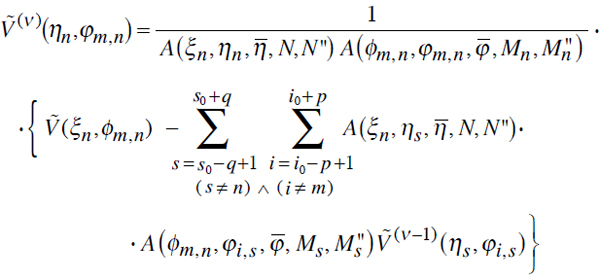 |
(17) |
wherein
 |
(18) |
Such an iterative relation allows one to evaluate in an easy, fast, and accurate way, the non-redundant uniform samples based on the knowledge of the irregularly distributed ones.
3. EXPERIMENTAL TESTING
Some laboratory results are reported in this section to give the experimental assessment of the described iterative technique for the correction of known probe position errors in a non-redundant spherical NTFF transformation for long AUTs. The proofs have been performed by means of the roll-over-azimuth spherical NF scanning system available at the UNISA Antenna Characterization Lab. The pyramidal absorbers, which cover the walls of the anechoic chamber, guarantee a reflection level lesser than – 40dB. A vector network analyzer is employed to carry out the measurements of the amplitude and phase of the voltage detected by the probe, an open-ended WR-90 rectangular waveguide. A waveguide slot array antenna manufactured by PROCOM and working at 10.4GHz is used as AUT. Such an antenna has been assembled by welding two cylinders on the narrow walls of a WR-90 waveguide and making 12 round-ended slots over its broad walls (Fig. 2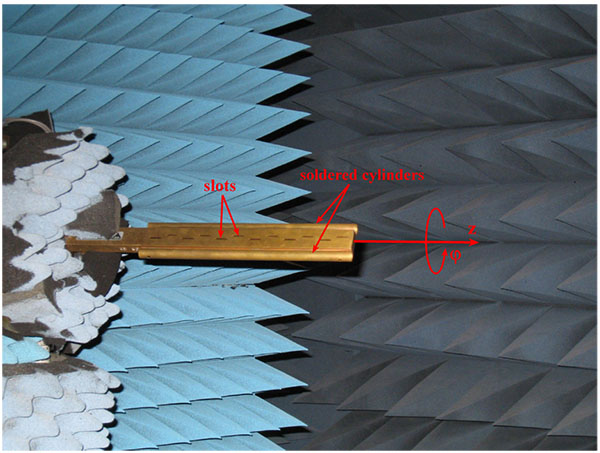 ). The AUT is positioned in such a way that its axis coincides with the z axis and its broad walls are parallel to the plane y = 0 (Figs. 1
). The AUT is positioned in such a way that its axis coincides with the z axis and its broad walls are parallel to the plane y = 0 (Figs. 1 and 2
and 2 ). A prolate spheroid having 2a = 36.34cm and 2b = 7.5cm has been adopted as source modelling. In order to assess experimentally the validity of the proposed technique in severe operative conditions, the acquired NF samples are intentionally not regularly spaced on a sphere with radius d = 42.0cm and their distribution is such that the imposed random shifts in η and φ between the positions of the non-uniform samples and the related uniform ones result to be uniformly distributed in (−Δη/3, Δη/3) and (−Δφn/3, Δφn/3).
). A prolate spheroid having 2a = 36.34cm and 2b = 7.5cm has been adopted as source modelling. In order to assess experimentally the validity of the proposed technique in severe operative conditions, the acquired NF samples are intentionally not regularly spaced on a sphere with radius d = 42.0cm and their distribution is such that the imposed random shifts in η and φ between the positions of the non-uniform samples and the related uniform ones result to be uniformly distributed in (−Δη/3, Δη/3) and (−Δφn/3, Δφn/3).
 |
Fig. (2) Photograph of the slotted waveguide antenna. |
The comparisons between the amplitudes of the probe voltage Vp directly measured (references) on the cut planes φ = 0° and φ = 90° and those recovered from the non-uniform samples by applying the iterative procedure are shown in Figs. (3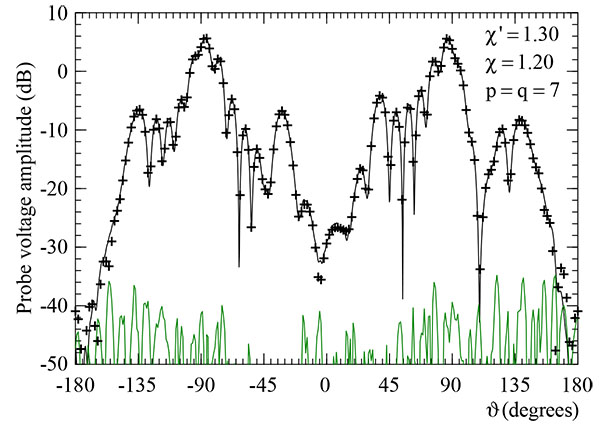 and 4
and 4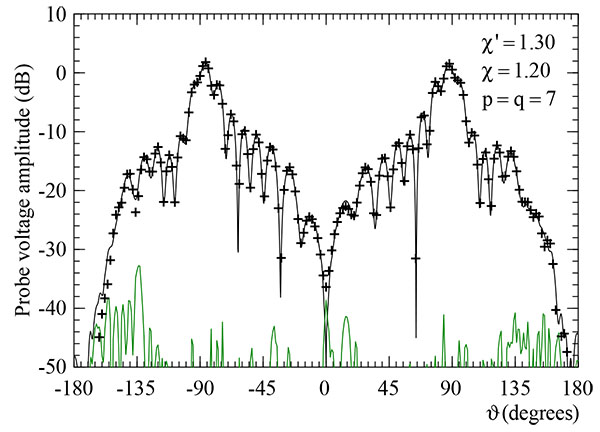 ), respectively. The errors in the corresponding reconstructed amplitudes are reported in the same figures. The corresponding results obtained without applying any correction procedure to the same non-uniform samples are reported in Figs. (5
), respectively. The errors in the corresponding reconstructed amplitudes are reported in the same figures. The corresponding results obtained without applying any correction procedure to the same non-uniform samples are reported in Figs. (5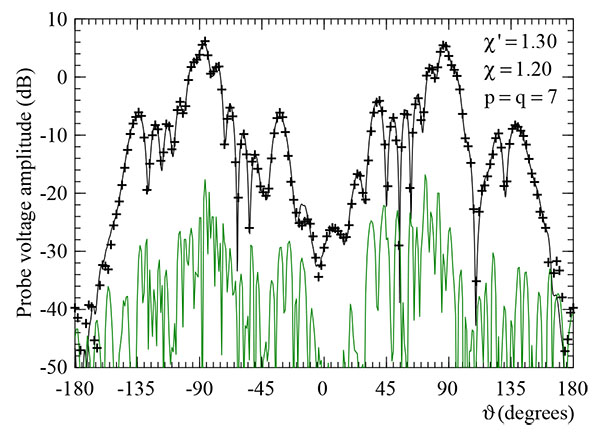 and 6
and 6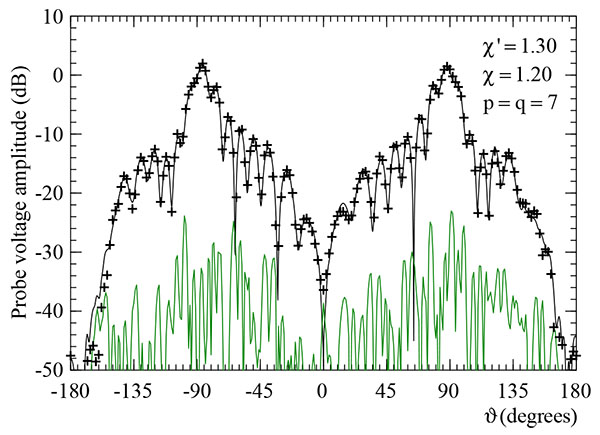 ) for sake of comparison. As can be clearly seen, the reconstruction error is remarkably greater when the iterative procedure is not applied. For completeness, the recovery of the phase of Vp on the cut plane φ = 0° is also shown in Fig. (7
) for sake of comparison. As can be clearly seen, the reconstruction error is remarkably greater when the iterative procedure is not applied. For completeness, the recovery of the phase of Vp on the cut plane φ = 0° is also shown in Fig. (7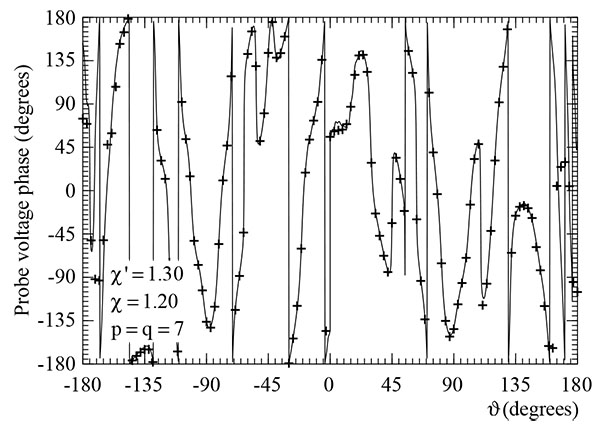 ). It can be clearly observed that, notwithstanding the large values of the imposed position errors, the reconstructions result to be very accurate, save for the zones characterized by very low voltage levels. It should be noticed that the above results have been obtained by using only 10 iterations, since, as shown by D’Agostino et al. in [28F. D’Agostino, F. Ferrara, C. Gennarelli, R. Guerriero, and M. Migliozzi, “Two techniques for compensating the probe positioning errors in the spherical NF–FF transformation for elongated antennas”, Open Electr. Electron. Eng. J., vol. 5, pp. 29–36, 2011.], this number of iterations guarantees that the iterative scheme converges with very low errors. Note that the uniform samples reconstruction process has taken a CPU time of about 0.67 seconds on a PC equipped with an Intel Core i5 @ 3.6GHz.
). It can be clearly observed that, notwithstanding the large values of the imposed position errors, the reconstructions result to be very accurate, save for the zones characterized by very low voltage levels. It should be noticed that the above results have been obtained by using only 10 iterations, since, as shown by D’Agostino et al. in [28F. D’Agostino, F. Ferrara, C. Gennarelli, R. Guerriero, and M. Migliozzi, “Two techniques for compensating the probe positioning errors in the spherical NF–FF transformation for elongated antennas”, Open Electr. Electron. Eng. J., vol. 5, pp. 29–36, 2011.], this number of iterations guarantees that the iterative scheme converges with very low errors. Note that the uniform samples reconstruction process has taken a CPU time of about 0.67 seconds on a PC equipped with an Intel Core i5 @ 3.6GHz.
 |
Fig. (7) Phase of Vp on the cut plane φ = 0°. Black line: reference; crosses: obtained from the knowledge of the irregularly spaced NF samples by applying the iterative procedure. |
The FF patterns in the E- and H-plane recovered from the non-uniform NF samples are compared in Figs. (8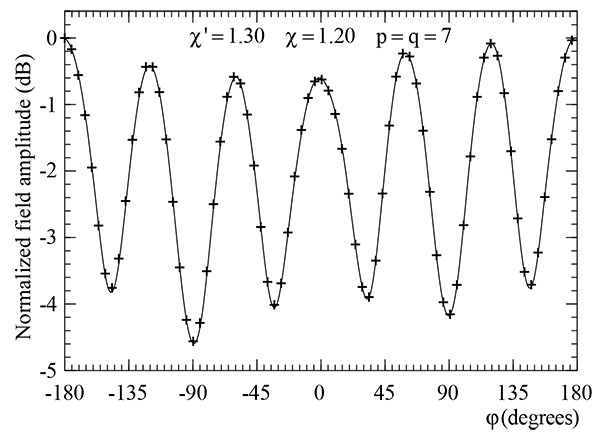 and 9
and 9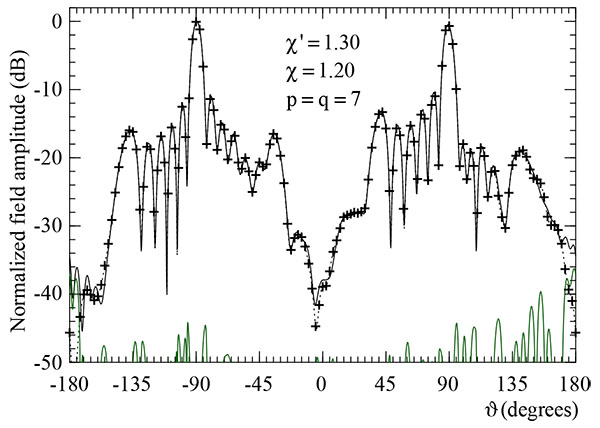 ) with the references patterns evaluated from the NF data directly measured at the points of the traditional spherical grid. The MI Technologies’ software MI 3000, implementing the traditional NTFF transformation [5J. Hald, J.E. Hansen, F. Jensen, and F.H. Larsen, Spherical Near-Field Antenna Measurements., J.E. Hansen, Ed., Peter Peregrinus: London, 1998], has been employed in both cases to get the FF patterns. For completeness, Fig. (10
) with the references patterns evaluated from the NF data directly measured at the points of the traditional spherical grid. The MI Technologies’ software MI 3000, implementing the traditional NTFF transformation [5J. Hald, J.E. Hansen, F. Jensen, and F.H. Larsen, Spherical Near-Field Antenna Measurements., J.E. Hansen, Ed., Peter Peregrinus: London, 1998], has been employed in both cases to get the FF patterns. For completeness, Fig. (10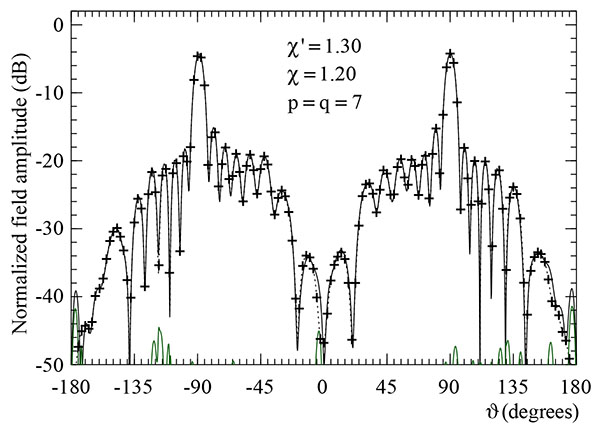 ) shows the reconstruction of the antenna FF pattern in the cut plane φ = 90°. As can be recognized, also the FF reconstructions are excellent. It must be noticed that the collected irregularly spaced NF samples are 1032, which are considerably lesser than those (5100) required when using the traditional NTFF transformation with spherical scanning. At last, for the sake of comparison, the reconstructed FF patterns in the H-plane and in the cut plane φ = 90°, obtained from the non-uniform NF samples without applying the iterative procedure, are reported in Figs. (11
) shows the reconstruction of the antenna FF pattern in the cut plane φ = 90°. As can be recognized, also the FF reconstructions are excellent. It must be noticed that the collected irregularly spaced NF samples are 1032, which are considerably lesser than those (5100) required when using the traditional NTFF transformation with spherical scanning. At last, for the sake of comparison, the reconstructed FF patterns in the H-plane and in the cut plane φ = 90°, obtained from the non-uniform NF samples without applying the iterative procedure, are reported in Figs. (11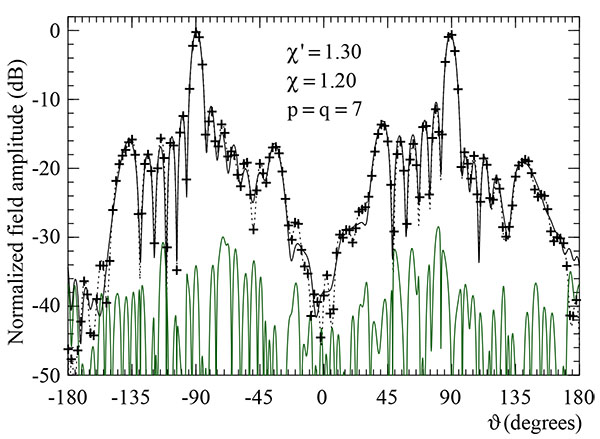 and 12
and 12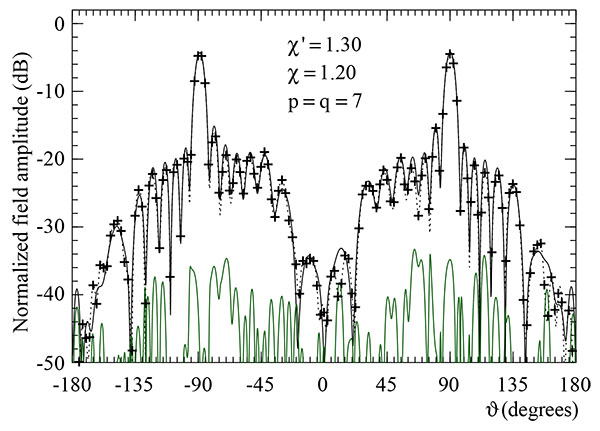 ). These last reconstructions appear significantly worsened with respect to the ones got when applying the iterative technique, thus further assessing its effectiveness for compensating known position errors. This becomes even more evident by comparing the very low reconstruction error levels in Figs. (9
). These last reconstructions appear significantly worsened with respect to the ones got when applying the iterative technique, thus further assessing its effectiveness for compensating known position errors. This becomes even more evident by comparing the very low reconstruction error levels in Figs. (9 and 10
and 10 ) with the remarkably greater ones in Figs. (11
) with the remarkably greater ones in Figs. (11 and 12
and 12 ).
).
 |
Fig. (8) FF pattern in the E-plane (ϑ = 90°). Black line: reference; crosses: obtained from the knowledge of the irregularly spaced NF samples by applying the iterative procedure. |
CONCLUSION
The experimental validation of an efficient technique for compensating known position errors in a spherical non-redundant NTFF transformation for elongated antennas has been provided in this paper. This technique, based on a iterative procedure, allows one to evaluate in an easy, fast, and accurate way the uniform samples at the points set by the non-redundant sampling representation based on the prolate ellipsoidal AUT modelling from the knowledge of the irregularly distributed ones. The very good NF and FF recoveries achieved when employing it in presence of large and pessimistic positioning errors, as compared with the worsened ones obtained when this procedure is not applied, assess experimentally its effectiveness.
CONSENT FOR PUBLICATION
Not applicable.
CONFLICT OF INTEREST
The authors declare no conflict of interest, financial or otherwise.
ACKNOWLEDGEMENTS
Declared none.
REFERENCES
| [1] | A.D. Yaghjian, "An overview of near-field antenna measurements", IEEE Trans. Antenn. Propag., vol. AP-34, pp. 30-45, 1986. [http://dx.doi.org/10.1109/TAP.1986.1143727] |
| [2] | M.H. Francis, and R.W. Wittmann, In: C.A. Balanis, Ed., Modern Antenna Handbook, John Wiley & Sons Inc.: Hoboken, NJ, USA, 2008 [http://dx.doi.org/10.1002/9780470294154.ch19] |
| [3] | M.H. Francis, Ed., IEEE Recommended Practice for Near-Field Antenna Measurements, IEEE Standard 1720-2012 |
| [4] | C. Gennarelli, A. Capozzoli, L. Foged, J. Fordham, D.J. van Rensburg, Eds., “Recent advances in near-field to far-field transformation techniques”, Int. J. Antennas Prop., vol. 2012, ID 243203, pp. 1-3, 2012. [http://dx.doi.org/10.1155/2012/243203] |
| [5] | J. Hald, J.E. Hansen, F. Jensen, and F.H. Larsen, Spherical Near-Field Antenna Measurements., J.E. Hansen, Ed., Peter Peregrinus: London, 1998 |
| [6] | F. Jensen, "On the probe compensation for near-field measurements on a sphere", Arch. Elektr. Uebertrag., vol. 29, pp. 306-308, 1975. |
| [7] | P.F. Wacker, Non-planar near-field measurements: Spherical scanning, 1975. [http://dx.doi.org/10.6028/NBS.IR.75-809] |
| [8] | F.H. Larsen, "Probe correction of spherical near-field measurements", Electron. Lett., vol. 13, pp. 393-395, 1977. [http://dx.doi.org/10.1049/el:19770287] |
| [9] | A.D. Yaghjian, and R.C. Wittmann, "The receiving antenna as a linear differential operator: application to spherical near-field measurements", IEEE Trans. Antenn. Propag., vol. AP-33, pp. 1175-1185, 1985. [http://dx.doi.org/10.1109/TAP.1985.1143520] |
| [10] | T. Laitinen, S. Pivnenko, J.M. Nielsen, and O. Breinbjerg, "Theory and practice of the FFT/matrix inversion technique for probe-corrected spherical near-field antenna measurements with high-order probes", IEEE Trans. Antenn. Propag., vol. 58, pp. 2623-2631, 2010. [http://dx.doi.org/10.1109/TAP.2010.2050437] |
| [11] | T.B. Hansen, "Spherical near-field scanning with higher-order probes", IEEE Trans. Antenn. Propag., vol. 59, pp. 4049-4059, 2011. [http://dx.doi.org/10.1109/TAP.2011.2164217] |
| [12] | M.A. Qureshi, C.H. Schmidt, and T.F. Eibert, "Adaptive sampling in spherical and cylindrical near-field antenna measurements", IEEE Antennas Propag. Mag., vol. 55, pp. 243-249, 2013. [http://dx.doi.org/10.1109/MAP.2013.6474537] |
| [13] | O.M. Bucci, C. Gennarelli, G. Riccio, and C. Savarese, "Data reduction in the NF–FF transformation technique with spherical scanning", J. Electromagn. Waves Appl., vol. 15, pp. 755-775, 2001. [http://dx.doi.org/10.1163/156939301X00995] |
| [14] | F. D’Agostino, F. Ferrara, C. Gennarelli, R. Guerriero, and M. Migliozzi, “Effective antenna modellings for NF-FF transformations with spherical scanning using the minimum number of data”, Int. J. Antennas Prop., vol. 2011, ID 936781, pp. 1-11, 2011. [http://dx.doi.org/10.1155/2011/936781] |
| [15] | F. D’Agostino, F. Ferrara, C. Gennarelli, R. Guerriero, and M. Migliozzi, "Non-redundant spherical NF – FF transformations using ellipsoidal antenna modeling: experimental assessments", IEEE Antennas Propag. Mag., vol. 55, pp. 166-175, 2013. [http://dx.doi.org/10.1109/MAP.2013.6645164] |
| [16] | F. D’Agostino, F. Ferrara, C. Gennarelli, R. Guerriero, and M. Migliozzi, “Experimental testing of nonredundant near-field to far-field transformations withspherical scanning using flexible modellings for nonvolumetric antennas”, Int. J. Antennas Prop., vol. 2013, ID 517934, pp. 1-10, 2013. [http://dx.doi.org/10.1155/2013/517934] |
| [17] | O.M. Bucci, and G. Franceschetti, "On the spatial bandwidth of scattered fields", IEEE Trans. Antenn. Propag., vol. 35, pp. 1445-1455, 1987. [http://dx.doi.org/10.1109/TAP.1987.1144024] |
| [18] | O.M. Bucci, C. Gennarelli, and C. Savarese, "Representation of electromagnetic fields over arbitrary surfaces by a finite and non redundant number of samples", IEEE Trans. Antenn. Propag., vol. 46, pp. 351-359, 1998. [http://dx.doi.org/10.1109/8.662654] |
| [19] | A. Dutt, and V. Rohklin, "Fast Fourier transforms for nonequispaced data", Proc. SIAM J. Sci. Comp., vol. 14, pp. 1369-1393, 1993. |
| [20] | R.C. Wittmann, B.K. Alpert, and M.H. Francis, "Near-field antenna measurements using nonideal measurement locations", IEEE Trans. Antenn. Propag., vol. 46, pp. 716-722, 1998. [http://dx.doi.org/10.1109/8.668916] |
| [21] | R.C. Wittmann, B.K. Alpert, and M.H. Francis, "Near-Field, spherical scanning antenna measurements with nonideal probe locations", IEEE Trans. Antenn. Propag., vol. 52, pp. 2184-2186, 2004. [http://dx.doi.org/10.1109/TAP.2004.832316] |
| [22] | O.M. Bucci, C. Gennarelli, and C. Savarese, "Interpolation of electromagnetic radiated fields over a plane from nonuniform samples", IEEE Trans. Antenn. Propag., vol. 41, pp. 1501-1508, 1993. [http://dx.doi.org/10.1109/8.267349] |
| [23] | F. D’Agostino, F. Ferrara, C. Gennarelli, R. Guerriero, and M. Migliozzi, "Two effective approaches to correct the positioning errors in a spherical near-field-far-field transformation", Electromag, vol. 36, pp. 78-93, 2016. [http://dx.doi.org/10.1080/02726343.2016.1136018] |
| [24] | F. Ferrara, C. Gennarelli, G. Riccio, and C. Savarese, "Far field reconstruction from nonuniform plane-polar data: a SVD based approach", Electromag, vol. 23, pp. 417-429, 2003. [http://dx.doi.org/10.1080/02726340390203171] |
| [25] | F. Ferrara, C. Gennarelli, G. Riccio, and C. Savarese, "NF–FF transformation with cylindrical scanning from nonuniformly distributed data", Microw. Opt. Technol. Lett., vol. 39, pp. 4-8, 2003. [http://dx.doi.org/10.1002/mop.11109] |
| [26] | F. D’Agostino, F. Ferrara, C. Gennarelli, R. Guerriero, and M. Migliozzi, "On the compensation of probe positioning errors when using a nonredundant cylindrical NF–FF transformation", Prog. Electromagn. Res. B, vol. 20, pp. 321-335, 2010. [http://dx.doi.org/10.2528/PIERB10032402] |
| [27] | F. D’Agostino, F. Ferrara, C. Gennarelli, R. Guerriero, and M. Migliozzi, "Two efficient procedures to correct the positioning errors in the plane-polar scanning", IET Microw. Antennas Propag., vol. 10, no. 13, pp. 1453-1458, 2016. [http://dx.doi.org/10.1049/iet-map.2016.0103] |
| [28] | F. D’Agostino, F. Ferrara, C. Gennarelli, R. Guerriero, and M. Migliozzi, “Two techniques for compensating the probe positioning errors in the spherical NF–FF transformation for elongated antennas”, Open Electr. Electron. Eng. J., vol. 5, pp. 29–36, 2011. |
| [29] | F. D’Agostino, F. Ferrara, C. Gennarelli, R. Guerriero, and M. Migliozzi, "Spherical near-field – far-field transformation for quasi-planar antennas from irregularly spaced data", J. Electromagn. Analysis Appl., vol. 4, pp. 147-155, 2012. [http://dx.doi.org/10.4236/jemaa.2012.44019]] |
| [30] | F. D’Agostino, F. Ferrara, C. Gennarelli, R. Guerriero, and M. Migliozzi, "Probe position errors corrected near-field-far-field transformation with spherical scanning", Appl. Comput. Electromagn. Soc. J., vol. 31, pp. 106-117, 2016. |
| [31] | F. D’Agostino, F. Ferrara, C. Gennarelli, R. Guerriero, and M. Migliozzi, "Far-field pattern evaluation from data acquired on a spherical surface by an inaccurately positioned probe", IEEE Antennas Wirel. Propag. Lett., vol. 15, pp. 402-405, 2016. [http://dx.doi.org/10.1109/LAWP.2015.2447840] |
| [32] | F. D’Agostino, F. Ferrara, C. Gennarelli, R. Guerriero, and M. Migliozzi, "Experimental validation of the SVD based approach to compensate the positioning errors in a nonredundant spherical NF–FF transformation", In: Proceeding of LAPC, 2014, pp. 31-35. [http://dx.doi.org/10.1109/LAPC.2014.6996313] |











